
Simca was a French automaker, founded in November 1934 by Fiat S.p.A. and directed from July 1935 to May 1963 by Italian Henri Pigozzi. Simca was affiliated with Fiat and, after Simca bought Ford's French subsidiary, became increasingly controlled by Chrysler. In 1970, Simca became a brand of Chrysler's European business, ending its period as an independent company. Simca disappeared in 1978, when Chrysler divested its European operations to another French automaker, PSA Peugeot Citroën. PSA replaced the Simca brand with Talbot after a short period when some models were badged as Simca-Talbots.

The Fiat 128 is a transverse front-engine, front wheel drive small family car manufactured and marketed by Fiat from 1969 to 1985 as a two- or four-door sedan, three- or five-door station wagon as well as two- or three-door coupé. The 128 running gear and engine, reconfigured for a mid-engined layout, were used in the Fiat X1/9 sports car.

The Fiat 500, commonly known as "Topolino", is an Italian city car produced and manufactured by Fiat from 1936 to 1955.
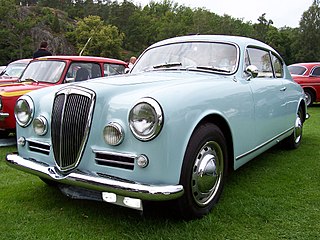
A grand tourer (GT) is a type of car that is designed for high speed and long-distance driving due to a combination of performance and luxury attributes. The most common format is a front-engine, rear-wheel-drive two-door coupé with either a two-seat or a 2+2 arrangement. Grand tourers are most often the coupé derivative of luxury saloons or sedans. Many iconic car models, such as the Ferrari 250 GT, Jaguar E-Type, and Aston Martin DB5, are considered classic examples of gran turismo cars.
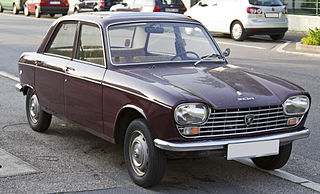
The Peugeot 204 is a small family car produced by the French manufacturer Peugeot between 1965 and 1976.
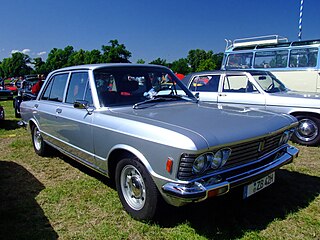
The Fiat 130 is a large six cylinder executive car produced by Italian car manufacturer Fiat from 1969 to 1977. It was available as a 4-door saloon and as a 2-door coupé.

The Fiat 1100 is a small family car produced from 1953 until 1969 by the Italian manufacturer Fiat. It was an all-new unibody replacement for the Fiat 1100 E, which descended from the pre-war, body-on-frame Fiat 508 C Balilla 1100. The 1100 was changed steadily and gradually until being replaced by the new Fiat 128 in 1969. There were also a series of light commercial versions of the 1100 built, with later models called the Fiat 1100T, which remained in production until 1971. The Fiat 1100 D also found a long life in India, where Premier Automobiles continued to build the car until the end of 2000.

The Lancia Fulvia is a car produced by Lancia between 1963 and 1976. Named after Via Fulvia, the Roman road leading from Tortona to Turin, it was introduced at the Geneva Motor Show in 1963 and manufactured in three variants: Berlina 4-door saloon, 2-door Coupé, and Sport, an alternative fastback coupé designed and built by Zagato on the Coupé floorpan.

The Lancia Beta was an entry-level luxury car produced by Italian car manufacturer Lancia from 1972 to 1984. It was the first new model introduced by Lancia after it had been taken over by Fiat in 1969.

The Fiat 850 is a small rear-engine, rear-wheel-drive car manufactured and marketed by Italian car manufacturer Fiat from 1964 to 1973.

The Lancia Gamma is an executive car manufactured and marketed by the Lancia subdivision of Fiat. Following its debut at the 1976 Geneva Motor Show as Lancia's new flagship, the Gamma was marketed as 4-door fastback saloon as the Berlina (1976-1984) and as 2-door coupé (1977-1984), both designed by Pininfarina — with 15,272 and 6,790 manufactured, respectively. The Gamma superseded the Lancia Flavia.

The Fiat 1300 and Fiat 1500 are a series of front-engine, rear-drive automobiles manufactured and marketed by Fiat from 1961 to 1967, replacing the Fiat 1400 and Fiat 1200 coupé, spyder and cabriolet. The 1300 and 1500 were essentially identical to each other except for their engine displacement, as indicated by their model names, and were offered in sedan/saloon, station wagon, convertible and coupé body styles which shared little mechanically with the other body styles except the 1500 engine.

The Fiat 518, also called Fiat Ardita, was a model of car produced by Italian car manufacturer Fiat between 1933 and 1938. The name "Ardita" was also used on the six-cylinder engined and more expensive Fiat Ardita 2500 or 527.

The Simca Aronde is an automobile which was manufactured by the French automaker Simca from 1951 to 1964. It was Simca's first original design, as well as the company's first unibody car. "Aronde" means "swallow" in Old French and it was chosen as the name for the model because Simca's logo at that time was a stylized swallow.
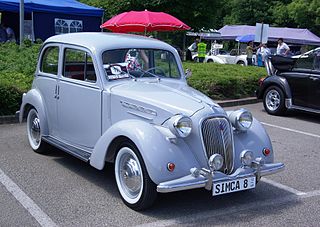
The Simca 8 is a small family car built by Simca and sold in France between November 1937 and 1951, available as a saloon, coupé or cabriolet. It was a rebadged Fiat 508C "nuova Balilla" made at Fiat's Simca plant in Nanterre, France.
The Turin Motor Show was an auto show held annually in Turin, Italy. The first official show took place between 21 and 24 April 1900, at the Castle of Valentino, becoming a permanent fixture in Turin from 1938 having shared it with Milan and Rome until that time. From 1972, the show was held biannually and in 1984, it moved into Fiat's shuttered Lingotto factory.

The Fiat-Abarth 750 is a compact sporting series of automobiles manufactured by the Italian manufacturing firm Abarth & C. of Turin, Italy in the 1950s and 1960s. The cars used the floorpan and often the bodywork of the Fiat 600 but were fitted with Abarth's modified engines. Abarth also offered a number of bodyworks by other designers for the 750 and its derivatives, most famously Zagato but also Allemano and others.
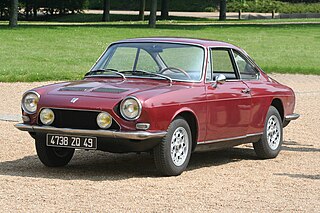
The Simca Coupé 1000 and its successor, the Simca 1200S are small, rear-engined two-door coupés which were produced by Simca between 1962 and 1971. Simca also provided the engine and the mechanical underpinnings while the small elegant bodies were built in Turin by Bertone before being transferred for final assembly to Simca's Poissy plant and an assembly plant in Rotterdam on specially configured trains.

The Fiat 1100 is a small family car produced from 1937 to 1953 by the Italian car manufacturer Fiat. It was introduced in 1937 as Fiat 508 C or Balilla 1100, as a replacement for the Fiat 508 Balilla. Under the new body the 508 C had more modern and refined mechanicals compared to the 508, including independent front suspension and an enlarged overhead valve engine. In 1939 it was updated and renamed simply Fiat 1100. The 1100 was produced in three consecutive series—1100, 1100 B and 1100 E—until 1953, when it was replaced by the all-new, unibody Fiat 1100/103.
The Fiat Abarth OTR 1000, alternatively also known as Fiat Abarth 1000 OTR, is a sporty subcompact model automobile produced by the Italian automobile manufacturer Abarth; with its special "Radiale" engine, it was built between 1964 and 1969 in various versions in very small numbers based on the Fiat 850.

































